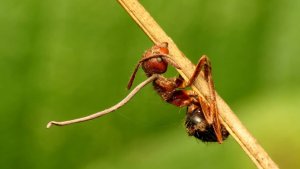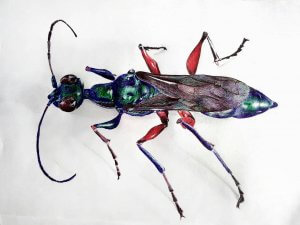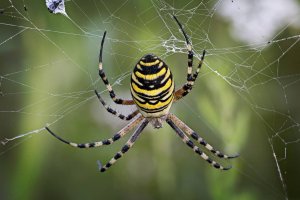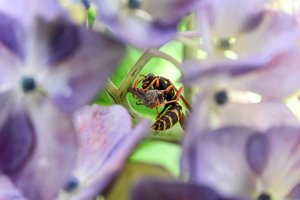Zombie insects! Oh my! In honor of the upcoming Halloween holiday, here are 7 zombie insects that give new meaning to Mother Nature’s serial killers!
Disclaimer: Do Not read This Too Soon After A Meal
Whether you are on a diet or not, reading this piece does not fare all with either appetites or appetizers.
Mother Nature has a macabre and horrifying side that is as bad as the worst horror flick to hit the big screen, although not many aspects may be as well known to most people, except for entomologists and perhaps those involved in pest-control and pest-management.
The insect world is replete with mystery and paradoxes, but there are few if any more nauseating than the world of zombie insects.
Read on if you dare and judge for yourself.
A Little Bit On The Zombie Legend
In keeping with the associations so prevalent with the advent of Halloween, the cultural origins of zombies seems a fitting topic for discussion before delving into their manifestations in the baffling world of insects.
The word is believed to be of West African origin, and was brought to Haiti by slaves from that region.
According to Haitian folklore, zombies are the byproducts of spells cast by sorcerers.

The earliest references to zombies in the United States were closely associated with slavery.
The word, zombi, which for years was spelled without the “e” at the end, first appeared in print in 1838 in an American newspaper in a reprinted short story called: The Unknown Painter.
University of California, Irvine, professor, Amy Wilentz, in an essay for The New York Times, referred to zombies as a “very logical offspring of New World slavery.” She further stated that because slavery in colonial Haiti was so viciously brutal, death was the only real escape and seen as a way to return to Africa…To become a zombie was the slave’s worst nightmare…to be dead and still a slave, an eternal field hand.”
There is a long history of zombies in American literature and cinema.
George Romero’s Night Of The Living Dead, produced right here in Pittsburgh of all places in 1968, is considered the classic cult film featuring the undead and at the same time, offering a social commentary by casting a black actor (Duane Jones) as the protagonist.
Many, unwittingly or not, symbolically linked the battle with the undead with that for civil rights rights.
But Mother Nature is no Mother Theresa, and her own cycle of life melodrama within the realm of insects can hold its own with elements of torture and suffering that are more terrifying that anything that could ever be conjured in the human imagination.
Read on, but eat much later.
The Most Horrifying Zombie Insect Parasites
While our pest-control and pest-management specialists at Pestco aren’t likely to run into these nasty parasitic organisms, that is not the case for many unfortunate insects.
The discovery of a 48 million-year-old fossilized leaf by a research team led by David Hughes of the University of Exeter in England, has revealed the oldest known evidence of parasitic manipulation of their hosts and the ability to turn them into zombies.
Hughes states:.“This leaf shows clear signs of one well documented form of zombie-parasite, a fungus, which infects ants and then manipulates their behavior.”
All types of living things both in and outside of the insect world are susceptible to deadly bodily invasion, but tracking down when and where such parasites evolved has been elusive until recent times.
Below are some horrifying examples of zombie-like phenomena occurring in the natural world of insects.
These deadly parasitic predators can turn their insect hosts into “zombies” and make them do everything from committing suicide to guarding the parasite’s offspring.
The Brazilian Jungle Fungus
Carpenter ants, which are often the subject of distress calls to the folks at Pestco, are the prey of choice for this fungus that is officially named: Ophiocordyceps unilateralis.ralis.
It reproduces and spreads by capturing and controlling the minds of carpenter ants.
According to the latest research, this microorganism is somehow able to recognize the brains of different ant species and releases its deadly cocktail only into its preferred host, indicating a sort of intelligence, which is horrifying enough in itself.
While this fungus does not transform the ants into zombies per se, according to a 2014 study, this parasite needs ants to complete its life cycle.
The fungus infects the ant with deadly spores, which release chemicals that enable it to take control of the poor insect’s nervous system.
This entity then forces the ant to climb up vegetation to the exact level of height and humidity that the fungus requires in order to thrive, and then compels the ant to clamp its jaws around a leaf before killing it.
The fungus quickly grows inside the dead ant’s body, eventually bursting through its head with a long stalk that releases more spores that infect new ants that while foraging, venture too close. (Appetizers, anyone?)

Other types of ants fall prey to parasitic flatworms known as Lancet Liver Flukes that take over the ant’s brain and compel it to climb up blades of grass, to expose it as prey to a larger animal.
Once the ant is eaten, the parasite reproduces inside the animal’s digestive tract, and when it is expelled, snails eat it and eliminate the parasites in the form of slime balls, which are very attractive to ants.
Mother Nature’s pesticides are far crueler than any employed by the pest-control and pest-maintenance experts at Pestco.
The Massospora Fungus
A study published in the journal, Fungal Ecology, reported the discovery of a fungus called Massospora that infects male cicadas, causing their abdomens and genitals to fall off.
Researchers reported that despite these missing body parts, male cicadas infected with this fungus “try to mate with everything they encounter” before dying.
This white, chalky fungus infects about five percent of cicadas, and it is transmitted via spores in the air.
Massospora sticks out of the bug’s back, causing a spread of the fungus every time the infected bug attempts to mate.
The fungus lurks in the soil until the cicadas emerge from the ground, some ingesting and activating it from a hormone within their own bodies.
Once gaining ingress, the fungus consumes the insides of the cicada and expands in size until it cracks open its exoskeleton.
This causes their genitals to fall off, and they are supplanted by a big white ball of spores.
This fungus affects diverse species of cicadas differently. While the dark brown, red-eyed Brood X get a boost from the stimulant, cathinonen, which is found in the fungus, annual cicadas absorb psilocybin, which is the same chemical found in psychedelic mushrooms.
(Losing your appetite? I wonder why?)
The Emerald Cockroach Wasp
Also known as the Jewel Wasp, this predator can manipulate the behavior of cockroaches, forcing them into servitude and turning them into passive hosts for its larvae.
A 2014 study revealed that this wasp first paralyzes its victim with one sting, then stings a second time, inserting a neural transmitter into the roach’s brain with all the precision of a trained surgeon.

While the roach eventually regains its ability to move, its actions are completely controlled by the wasp and it can do nothing to prevent the wasp from laying its eggs in its abdomen and becoming a fresh meal once the wasp larvae hatches.
Parasitic Worms Know As Acanthocephalans
Pill bugs aka wood louses, potato bugs or roly polies, sometimes ingest and become the unwilling hosts of parasitic worms known as acanthocephalans.
Their means of operation are as diabolical as anything known in nature.
The parasite takes over the bug’s brain, grows inside it, and compels the bug to become easy prey for birds because the worms need to be inside the birds’ digestive tracts in order to mature fully.
It does this by forcing the bug to expose itself in broad daylight and leading the darkly colored bug to crawl upon a lightly colored surface, where birds, such as starlings, can easily see it.
The poor bug waits to be eaten and can do nothing to stop it.
The Ecuadorian Zatypota Wasp
According to a 2018 study, the Zatypota wasp lays its egg in the abdomen of an Anelosimus eximius, a type of social spider and transforms it into a hapless zombie, altering its behavior as a communal insect.
Once the egg hatches, the larva attaches itself to the spider and forces its to move away from its nest and create a cocoon-shaped web of its own.
The wasp larvae feed upon the spider victim’s blood until the spider dies.
A Type of Costa Rican Wasp
The tropical wasp species, Hymenoepimecis argyraphaga, is a parasite that attacks the web of the Orb Weaver Spider.
When the female wasp is ready to lay her egg, she begins the first part of her cruel process by stinging the spider with a cocktail of toxins and mind-altering chemicals that paralyzes it, and then lays an egg on its abdomen.

Soon, the egg hatches and the larva that emerges remains attached to the spider, sucking hemolymph (a kind of blood) from its body for nourishment.
During the first weeks of nourishment, the spider lives its life without incident, but all that changes when the wasp larvae prepare to move on to the next life cycle, which requires a special heavy cocoon.
The wasp forces the spider to build the web that it needs by injecting a chemical that alters its behavior.
The zombie spider begins the process as it normally would, but instead of completing all the steps to create a careful pattern, it simply repeats the first few over and over again, resulting in a web that contains a few heavily-reinforced anchor threads and a small center section.
Perhaps the cruelest aspect of all is that after the web is done, the spider crawls to the center of the web and remains there as the larvae molts and then kills and eats it, sucking any remaining useful bits out from its corpse and then throwing it away like a piece of garbage.
It then lives in the cocoon for a few weeks, supported by the strength of the web, before emerging as an adult wasp and flying away, only to continue the cycle.
The European Paper Wasp
A fly-like parasite known as Xenos vesparum attacks paper wasps, causing them to withdraw from their colony and disregard their specific niche within the usually inflexible wasp social order.
This is extremely bizarre even in a world of zombie insects where weird is commonplace albeit not often addressed by the pest-control and pest maintenance specialists at Pestco.

Eventually, the infected wasp mates with other infected wasps.
Those infected with male parasites die, but female zombie queens are born from exposure to female parasites.
According to entomologist, Fabio Manfredini of Pennsylvania State University, co-author of a 2011 study entitled Animal Behavior :
“There are many examples of parasites that induce hosts to new behavior, which is out of their normal life cycles.
But in this case, the host is doing something that’s not appropriate for its caste.
By altering everything from individual wasps’ bodies and behaviors to colony caste structures, this bizarre parasite-parasitoid … breaks all the traditional rules.
In Conclusion
Do zombies stagger among us?
Well maybe not the human kind, but other varieties certainly do crawl across our minds at this time of year when the critters of the insect world take their place among more conventional ghosts and goblins.
They can hold their own when it comes to sadistic torture and mayhem.
Happy Halloween and…sleep well, dear reader!
And don’t forget to call Pestco Professional Services for any of your Pittsburgh or Western Pennsylvania pest control needs! (412) 252-5200

Photo Credits: Pixabay
Lead image Credit: Ant killed by Ophiocordyceps fungus in Florida. Photo © Katja Schulz / Flickr
 Over 300 Reviews
Over 300 Reviews 